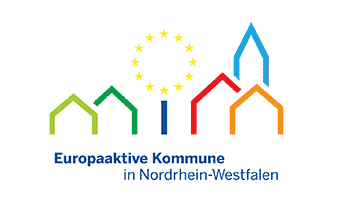Inhalt
Historischer Rundweg - Board III
Catholic Church Heilig Kreuz (Holy Cross)
The church is a three-aisled gothic brick-building with a raised middle nave, transept and three-sided choir and was ceremoniously consecrated in 1896.
Previous buildings
The village of Wemb (written forms: Wembde, Winden, Wimme, Wemm, Wem, Weymde) is first mentioned in 1345. It belonged according to census records from 1397 along with the farm communities Vornick, Boekhöltchen (partially), Hoest, Rottum, Vorselaer, Wissen, Keylaer, Am Bruch, Steeg, Baal, Oberhelsum and Niederhelsum and the village of Weeze to the court district and diocese Weeze in the department of Goch. There was a small chapel in Wemb, which is mentioned in the 16th century as an Exaltation of the Cross chapel. In 1714 the Weeze vicarage refurbished the decaying chapel, despite the fact that the goverment of Cleves had forbidden this renovation as well as the holding of services there. Pastoral care was not possible again until 1723, when a Franciscan father, probably from the Marienwasser Monastery near Weeze, took over this duty. In 1804 Wemb along with Hees and Baal were promoted to an independent parish. The first vicar was Johann Lüskens, the last prior of the Monastery of Marienwasser, the secularisation of which was rescinded through the French in 1802.
New building
In 1862 the church spire was struck by lightning. The church and organ were severely damaged and patched up as best as was possible at the time. As the church had become too small for the growing community, the building of a new one was undertaken. In 1889 an insufficient extension was initially created. Numerous donations eventually led to a new design from the well-known Cologne architects Rüdell and Odenthal. The old church from 1806 and the extension were eventually torn down and in 1895/1896 a three-aisled gothic brick-building with a raised middle nave, transept and three-sided choir was built in their place. On November 12th, 1896 the Church was ceremoniously consecrated.
Furnishings
The majestically carved pulpit as well as the monstrance originate from the church of the former Marienwasser Monastery. The high altar with its theme of the passion of the Christ and the message of the Cross stem from the workshop of Ferdinand Langenberg in Goch.
Its panel paintings, „The enthroned Maddona with Child“ and „St. Joseph“ were painted in 1908 by the artist Gerhard Schoofs, who was born in Weeze. The painted panels on the reverse side “Bread from Heaven“ (Mannales) and „Moses, who draws water from the Rock“ were created by Gerhard Lamers from Cleves.
The magnificent doors of the tabernacle were designed and made in 1897 in the goldsmith’s of Franz Wilhelm van den Wyenbergh in Kevelaer.
The altar of Mary was designed and made in 1909 by the sculptor Jacob Ophey from Geldern. The war-damaged „Sacred Heart of Jesus altar“ was restaurated based on the altar of Mary in 2004 by the carving workshop Müller from Brühl. The wooden sculpture of St. Joseph with saw and wood plane on the northern wall of the church can be attributed to Ferdinand Dierker from Kevelaer.
The windows of the choir were designed by stained-glass artist Richtstätte in 1955. They depict in the middle the Hand of God, below the crucifixion and the resurrection, to the left the old testamental references to the sacrifice of the cross and to the right the fruits of the sacrifice of the cross: the Forgiving of Sins, Rising from the Dead and Healing of afflictions. The windows on the side aisle, designed by the Weeze artist Mennekes, show the symbols of the sacrament.
Merger
Since the merger in 2005 of the two catholic parishes of Weeze and Wemb, the Heilig Kreuz Church (Holy Cross Church) is a subsidiary of „St. Cyriakus in Weeze“.
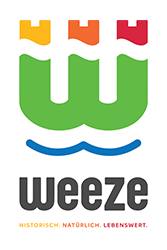

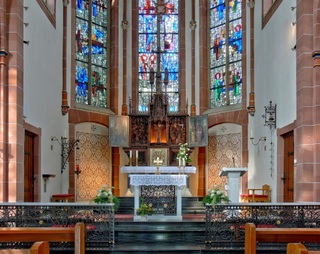
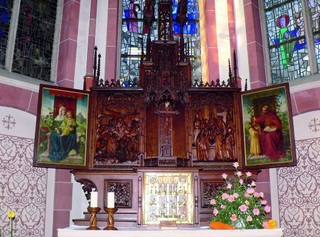
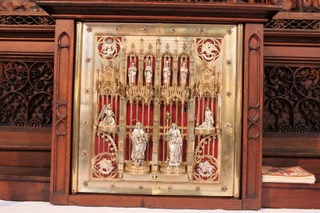
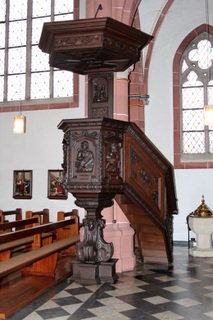
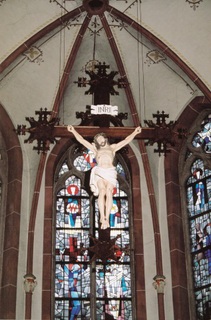
 02837 9100 (Zentrale)
02837 9100 (Zentrale) info@weeze.de
info@weeze.de Facebook
Facebook